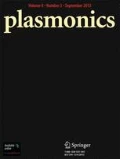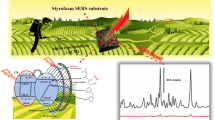Abstract
Flexible surface-enhanced Raman scattering (SERS) substrates possess additional advantages over conventional solid substrates because of their capability to conform to real surfaces having arbitrary shapes which consequently improves the trace collection efficiency. However, the high-cost and cumbersome pre-requisite template preparation method is a major bottleneck for their use in real-world applications. In this study, we systematically explore cheaper and commonly available daily-routine materials like A4 printing paper, sandpaper, Al foil, crumbled Al foil, and carbon and scotch tapes directly utilizing them as SERS pre-templates. Inherent roughness of the deployed material directly serves the purpose of reducing the patterning fabrication cost by a considerable amount. However, SERS behaviors of all the above templates are investigated by depositing a requisite plasmonic active Au-Ag alloy nanolayer of identical thickness over them. By using Rh6G dye and methylene blue as detecting molecules, Raman responses of all the samples are compared. Interestingly, crumbled Al foil exhibits a significantly higher and sharp Raman response for both the analytes among all templates. In addition, pesticide detection with varying concentrations was performed on this proposed substrate. An enhancement factor of 6.36\(\times\)10\(^{7}\) is observed over crumbled Al foil in comparison with conventional bare Si. We believe this study facilitates the way of designing cheaper and ready-to-use SERS substrates for on-field detection application and will help in bringing out laboratory-like results for industrial applications without the need of any cost-intensive fabrication methods.






Similar content being viewed by others
Availability of Data and Material
The authors confirm that the data and material supporting the findings of this study are available within the article.
Code Availability
Not applicable.
References
Shi R, Liu X, Ying Y (2017) Facing challenges in real-life application of surface-enhanced Raman scattering: Design and nanofabrication of surface-enhanced Raman scattering substrates for rapid field test of food contaminants. J Agric Food Chem 66(26):6525–6543. https://doi.org/10.1021/acs.jafc.7b03075
Tay L-L, Poirier S, Ghaemi A, Hulse J, Wang S (2021) Paper-based surface-enhanced Raman spectroscopy sensors for field applications. J Raman Spectros 52(2):563–572
Zhang D, Pu H, Huang L, Sun D-W (2021) Advances in flexible surface-enhanced Raman scattering (SERS) substrates for nondestructive food detection: Fundamentals and recent applications. Trends Food Sci Technol 109:690–701. https://doi.org/10.1016/j.tifs.2021.01.058
Li Z, Huang X, Lu G (2020) Recent developments of flexible and transparent SERS substrates. J Mater Chem C 8:3956–3969
Xu K, Zhou R, Takei K, Hong M (2019) Toward flexible surface-enhanced Raman scattering (SERS) sensors for point-of-care diagnostics. Adv Sci 6(16):1900925. https://doi.org/10.1002/advs.201900925
Langer J, Jimenez de Aberasturi D, Aizpurua J, Alvarez-Puebla RA, Auguié B, Baumberg JJ, Bazan GC, Bell SEJ, Boisen A, Brolo AG, Choo J, Cialla-May D, Deckert V, Fabris L, Faulds K, García de Abajo FJ, Goodacre R, Graham D, Haes AJ, Haynes CL, Huck C, Itoh T, Käll M, Kneipp J, Kotov NA, Kuang H, Le Ru EC, Lee HK, Li J-F, Ling XY, Maier SA, Mayerhöfer T, Moskovits M, Murakoshi K, Nam J-M, Nie S, Ozaki Y, Pastoriza-Santos I, Perez-Juste J, Popp J, Pucci A, Reich S, Ren B, Schatz GC, Shegai T, Schlücker S, Tay L-L, Thomas KG, Tian Z-Q, Van Duyne RP, Vo-Dinh T, Wang Y, Willets KA, Xu C, Xu H, Xu Y, Yamamoto YS, Zhao B, Liz-Marzán LM (2018) Present and future of surface-enhanced Raman scattering. ACS Nano
Liu X, Ma J, Jiang P, Shen J, Wang R, Wang Y, Tu G (2020) Large-scale flexible surface-enhanced Raman scattering (SERS) sensors with high stability and signal homogeneity. ACS Appl Mater Interfaces 12(40):45332–45341
Gong X, Tang M, Gong Z, Qiu Z, Wang D, Fan M (2019) Screening pesticide residues on fruit peels using portable Raman spectrometer combined with adhesive tape sampling. Food Chem 295:254–258. https://doi.org/10.1016/j.foodchem.2019.05.127
Korkmaz A, Kenton M, Aksin G, Kahraman M, Wachsmann-Hogiu S (2018) Inexpensive and flexible SERS substrates on adhesive tape based on biosilica plasmonic nanocomposites. ACS Appl Nano Mater 1(9):5316–5326
Xu H, Bjerneld EJ, Käll M, Börjesson L (1999) Spectroscopy of single hemoglobin molecules by surface enhanced Raman scattering. Phys Rev Lett 83:4357–4360
Karadan P, Aggarwal S, Anappara AA, Narayana C, Barshilia HC (2018) Tailored periodic si nanopillar based architectures as highly sensitive universal SERS biosensing platform. Sens Actuators B Chem 254:264–271. https://doi.org/10.1016/j.snb.2017.07.088
Ouyang L, Ren W, Zhu L, Irudayaraj J (2017) Prosperity to challenges: recent approaches in SERS substrate fabrication. Rev Anal Chem 36(1). http://doi.org/10.1515/revac-2016-0027
Ru EL, Etchegoin P (2008) Principles of surface-enhanced raman spectroscopy: and related plasmonic effects. Elsevier Sci
Xie W, Schlücker S (2014) Rationally designed multifunctional plasmonic nanostructures for surface-enhanced Raman spectroscopy: a review. Rep Prog Phys 77(11), 116502
Persson BNJ, Zhao K, Zhang Z (2006) Chemical contribution to surface-enhanced Raman scattering. Phys Rev Lett 96, 207401
Abu Hatab NA, Oran JM, Sepaniak MJ (2008) Surface-enhanced Raman spectroscopy substrates created via electron beam lithography and nanotransfer printing. ACS Nano 2(2):377–385. https://doi.org/10.1021/nn7003487
Petti L, Capasso R, Rippa M, Pannico M, La Manna P, Peluso G, Calarco A, Bobeico E, Musto P (2016) A plasmonic nanostructure fabricated by electron beam lithography as a sensitive and highly homogeneous SERS substrate for bio-sensing applications. Vib Spectrosc 82:22–30. https://doi.org/10.1016/j.vibspec.2015.11.007
Shinki, Sarkar S (2020) Dependence of the far-field optical response of Ion beam sculpted Cu thin films on their surface correlations. Appl Surf Sci 526, 146473. http://doi.org/10.1016/j.apsusc.2020.146473
Saini M, Augustine S, Ranjan M, Som T (2020) In-plane optical anisotropy and SERS detection efficiency of self-organized gold nanoparticles on silicon nanoripples: Roles of growth angle and postgrowth annealing. Appl Surf Sci 512, 145703
Schreiber B, Gkogkou D, Dedelaite L, Kerbusch J, Hübner R, Sheremet E, Zahn DRT, Ramanavicius A, Facsko S, Rodriguez RD (2018) Large-scale self-organized gold nanostructures with bidirectional plasmon resonances for SERS. RSC Adv 8:22569–22576. https://doi.org/10.1039/C8RA04031A
Zhang C, Jiang SZ, Huo YY, Liu AH, Xu SC, Liu XY, Sun ZC, Xu YY, Li Z, Man BY (2015) SERS detection of r6g based on a novel graphene oxide/silver nanoparticles/silicon pyramid arrays structure. Opt Express 23(19):24811–24821
Roy A, Maiti A, Chini TK, Satpati B (2017) Annealing induced morphology of silver nanoparticles on pyramidal silicon surface and their application to surface-enhanced Raman scattering. ACS Appl Mater Interfaces 9(39):34405–34415
Shinki, Sarkar S (2020) Au0.5Ag0.5alloy nanolayer deposited on pyramidal Si arrays as substrates for surface-enhanced Raman spectroscopy. ACS Appl Nano Mater 3(7), 7088–7095. https://doi.org/10.1021/acsanm.0c01407
Guo Q, Xu M, Yuan Y, Gu R, Yao J (2016) Self-assembled large-scale monolayer of au nanoparticles at the air/water interface used as a SERS substrate. Langmuir 32(18):4530–4537
Yang G, Nanda J, Wang B, Chen G, Hallinan DT (2017) Self-assembly of large gold nanoparticles for surface-enhanced Raman spectroscopy. ACS Appl Mater Interfaces 9(15):13457–13470
Wang M, Zhang Z, He J (2015) A SERS study on the assembly behavior of gold nanoparticles at the oil/water interface. Langmuir 31(47):12911–12919
Linh VTN, Moon J, Mun C, Devaraj V, Oh J-W, Park S-G, Kim D-H, Choo J, Lee Y-I, Jung HS (2019) A facile low-cost paper-based SERS substrate for label-free molecular detection. Sens Actuators B Chem 291:369–377. https://doi.org/10.1016/j.snb.2019.04.077
Suresh V, Ding L, Chew AB, Yap FL (2018) Fabrication of large-area flexible SERS substrates by nanoimprint lithography. ACS Appl Nano Mater 1(2):886–893. https://doi.org/10.1021/acsanm.7b00295
Kumar S, Goel P, Singh JP (2017) Flexible and robust SERS active substrates for conformal rapid detection of pesticide residues from fruits. Sens Actuators B Chem 241:577–583. https://doi.org/10.1016/j.snb.2016.10.106
Wang Y, Zhang M, Feng L, Dong B, Xu T, Li D, Jiang L, Chi L (2019) Tape-imprinted hierarchical lotus seedpod-like arrays for extraordinary surface-enhanced Raman spectroscopy. Small 15(19):1804527. https://doi.org/10.1002/smll.201804527
Mosier-Boss PA (2017) Review of SERS substrates for chemical sensing. Nanomaterials 7(6):142
Sun J, Gong L, Gong Z, Wang D, Yin X, Fan M (2019) Facile fabrication of a large-area and cost-effective PDMS-SERS substrate by sandpaper template-assisted lithography. Anal Methods 11:4917–4922
Suresh V, Yap FL (2015) Flexible, transparent and robust SERS tapes through a two-step block copolymer self-assembly process. RSC Adv 5:61671–61677
Muhammad M, Yan B, Yao G, Chao K, Zhu C, Huang Q (2020) Surface-enhanced Raman spectroscopy for trace detection of tetracycline and dicyandiamide in milk using transparent substrate of ag nanoparticle arrays. ACS Appl Nano Mater 3(7):7066–7075
Lee CH, Hankus ME, Tian L, Pellegrino PM, Singamaneni S (2011) Highly sensitive surface enhanced Raman scattering substrates based on filter paper loaded with plasmonic nanostructures. Anal Chem 83(23):8953–8958. https://doi.org/10.1021/ac2016882
Lee CH, Tian L, Singamaneni S (2010) Paper-based SERS swab for rapid trace detection on real-world surfaces. ACS Appl Mater Interfaces 2(12):3429–3435. https://doi.org/10.1021/am1009875
Walsh RJ, Chumanov G (2001) Silver coated porous alumina as a new substrate for surface-enhanced Raman scattering. Appl Spectrosc 55(12):1695–1700
Muniz-Miranda M, Gellini C, Giorgetti E, Margheri G, Marsili P, Lascialfari L, Becucci L, Trigari S, Giammanco F (2013) Nanostructured films of metal particles obtained by laser ablation. Thin Solid Films 543:118–121
Kruszewski S (1994) Influence of surface roughness variations on the surface enhanced Raman scattering signal. In: Pluta M, Szyjer M (eds.) Diffractometry and Scatterometry vol. 1991, pp. 181–188. SPIE
Kruszewski S (1994) Dependence of SERS signal on surface roughness. Surf Interface Anal 21(12):830–838
Zhao Y, Liu X, Lei DY, Chai Y (2014) Effects of surface roughness of ag thin films on surface-enhanced Raman spectroscopy of graphene: spatial nonlocality and physisorption strain. Nanoscale 6:1311–1317
Li C, Huang Y, Lai K, Rasco BA, Fan Y (2016) Analysis of trace methylene blue in fish muscles using ultra-sensitive surface-enhanced Raman spectroscopy. Food Control 65:99–105
Xu S, Jiang S, Wang J, Wei J, Yue W, Ma Y (2016) Graphene isolated au nanoparticle arrays with high reproducibility for high-performance surface-enhanced Raman scattering. Sens Actuators B Chem 222:1175–1183
Wang P, Liang O, Zhang W, Schroeder T, Xie Y-H (2013) Ultra-sensitive graphene-plasmonic hybrid platform for label-free detection. Adv Mater 25(35), 4918–4924
Mu Y, Zhang X (2020) A paper-fiber-supported 3D SERS substrate. Plasmonics 15(3):889–896
Shinki, Singh J, Sarkar S (2021) Tuning the topographical parameters of Si pyramids for a better surface enhanced Raman response. Phys Chem Chem Phys 23, 26407–26416
Acknowledgements
The authors sincerely acknowledge Central Research Facility (CRF), IIT Ropar, for giving access to AFM, SEM, EDX, XRD, and Raman facilities for measurements.
Author information
Authors and Affiliations
Contributions
Shinki performed the conceptualization, methodology, validation, and writing of the manuscript. S. Sarkar performed the writing-review, editing, and overall supervision.
Corresponding author
Ethics declarations
Ethics Approval
Not applicable (this work does not involve human subjects and/or animals)
Consent to Participate
Informed consent was obtained from all individual participants included in the study.
Consent for Publication
The participant has consented to the submission of the case report to the journal.
Conflict of Interest
The authors declare no competing interests.
Additional information
Publisher’s Note
Springer Nature remains neutral with regard to jurisdictional claims in published maps and institutional affiliations.
Supplementary Information
Below is the link to the electronic supplementary material.
11468_2022_1618_MOESM1_ESM.pdf
Supplementary file1: (a) EdX report confirming the Au-Ag alloy atomic concentration (b) Chemical structure of used probe molecules Rhodamine 6G and Methylene blue respectively (c) Background Raman spectra of carbon tape (d) Calculation of SERS enhancement factor (PDF 332 KB)
Rights and permissions
About this article
Cite this article
Shinki, Sarkar, S. Daily-Life Candidates as Flexible SERS Substrates for Pesticide Detection: a Comparative Study. Plasmonics 17, 1293–1303 (2022). https://doi.org/10.1007/s11468-022-01618-7
Received:
Accepted:
Published:
Issue Date:
DOI: https://doi.org/10.1007/s11468-022-01618-7




